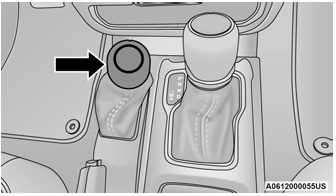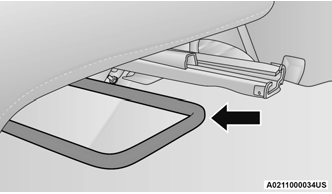Jeep Wrangler: FOUR–WHEEL DRIVE OPERATION / Four-Position Transfer Case — If Equipped

Four-Wheel Drive Gear Selector
The transfer case provides four mode positions:
- 2H (2WD High) — Two-Wheel Drive High Range
- 4H (4WD High) —Four-Wheel Drive High Range
- N (Neutral)
- 4L (4WD Low) — Four-Wheel Drive Low Range
For additional information on the appropriate use of each transfer case mode position, see the information below:
2WD High
Two-Wheel Drive High Range — This range is for normal street and highway driving on dry, hard surfaced roads.
4WD High
Four-Wheel Drive High Range — This range maximizes torque to the front driveshaft, forcing the front and rear wheels to rotate at the same speed. This range provides additional traction for loose, slippery road surfaces only.
N (Neutral)
WARNING!
You or others could be injured or killed if you leave the vehicle unattended with the transfer case in the (N) Neutral position without first fully engaging the parking brake. The transfer case (N) Neutral position disengages both the front and rear driveshafts from the powertrain, and will allow the vehicle to roll, even if the automatic transmission is in PARK (or manual transmission is in gear). The parking brake should always be applied when the driver is not in the vehicle.
N (Neutral) — This range disengages both the front and rear driveshafts from the powertrain. To be used for flat towing behind another vehicle.
4WD Low
Four-Wheel Drive Low Range — This range provides low speed four-wheel drive. It maximizes torque to the front driveshaft, forcing the front and rear wheels to rotate at the same speed. This range provides additional traction and maximum pulling power for loose, slippery road surfaces only. Do not exceed 25 mph (40 km/h).
The transfer case is intended to be driven in the 2WD High position for normal street and highway conditions, such as hard-surfaced roads.
In the event that additional traction is required, the transfer case 4WD High and 4WD Low positions can be used to lock the front and rear driveshafts together, forcing the front and rear wheels to rotate at the same speed. The 4WD High and 4WD Low positions are intended for loose, slippery road surfaces only and not intended for normal driving. Driving in the 4WD High and 4WD Low positions on hard-surfaced roads will cause increased tire wear and damage to the driveline components. Refer to “Shifting Procedures” in this section for further information on shifting into 4WD High or 4WD Low.
The instrument cluster alerts the driver that the vehicle is in four-wheel drive, and the front and rear driveshafts are locked together. The light will illuminate when the transfer case is shifted into the 4WD High position.
When operating your vehicle in 4WD Low, the engine speed will be approximately three times (four times for Rubicon models) that of the 2WD High or 4WD High positions at a given road speed. Take care not to overspeed the engine.
Proper operation of four-wheel drive vehicles depends on tires of equal size, type, and circumference on each wheel. Any difference will adversely affect shifting and cause damage to the transfer case.
Because four-wheel drive provides improved traction, there is a tendency to exceed safe turning and stopping speeds. Do not go faster than road conditions permit.
Shifting Procedures
2WD High To 4WD High Or 4WD High To 2WD High
Shifting between 2WD High and 4WD High can be made with the vehicle stopped or in motion. The preferred shifting speed would be 0 to 45 mph (72 km/h). With the vehicle in motion, the transfer case will engage/disengage faster if you momentarily release the accelerator pedal after completing the shift. Do not accelerate while shifting the transfer case.
Apply a constant force when shifting the transfer case lever.
NOTE:
- Do not attempt to make a shift while only the front or rear wheels are spinning. The front and rear driveshaft speeds must be equal for the shift to take place. Shifting while only the front or rear wheels are spinning can cause damage to the transfer case.
- Delayed shifts out of four-wheel drive may be experienced due to uneven tire wear, low or uneven tire pressures, excessive vehicle loading, or cold temperatures.
- Shifting effort will increase with speed, this is normal.
During cold weather, you may experience increased effort in shifting until the transfer case fluid warms up. This is normal.
4WD High To 4WD Low Or 4WD Low To 4WD High
With the vehicle rolling at 1 to 3 mph (2 to 5 km/h), shift an automatic transmission into NEUTRAL (N), or press the clutch pedal on a manual transmission. While the vehicle is coasting at 1 to 3 mph (2 to 5 km/h), shift the transfer case lever firmly to the desired position. Do not pause with the transfer case in N (Neutral). Once the shift is completed, place the automatic transmission into DRIVE or release the clutch pedal on a manual transmission.
NOTE:
Shifting into or out of 4WD Low is possible with the vehicle completely stopped; however, difficulty may occur due to the mating teeth not being properly aligned. Several attempts may be required for clutch teeth alignment and shift completion to occur. The preferred method is with the vehicle rolling at 1 to 3 mph (2 to 5 km/h). Avoid attempting to engage or disengage 4WD Low with the vehicle moving faster than 1 to 3 mph (2 to 5 km/h).
WARNING!
Failure to engage a transfer case position completely can cause transfer case damage or loss of power and vehicle control. You could have a collision. Do not drive the vehicle unless the transfer case is fully engaged.
 FOUR–WHEEL DRIVE OPERATION
FOUR–WHEEL DRIVE OPERATION
WARNING!
Failure to engage a transfer case position
completely can cause transfer case damage
or loss of power and vehicle control. You
could have a collision...
 Five-Position Transfer Case — If Equipped
Five-Position Transfer Case — If Equipped
Four-Wheel Drive Gear Selector
The transfer case provides five mode positions:
2H (2WD High) — Two-Wheel Drive High Range
4H AUTO (4WD High AUTO) — Four-Wheel Drive Auto High Range
4H PT (4WD High PT) — Four-Wheel Drive Part Time High Range
N (Neutral)
4L (4WD Low) — Four-Wheel Drive Low Range
For additional information on the appropriate
use of each transfer case mode position, see
the information below:
2WD High
Two-Wheel Drive High Range — This range is for
normal street and highway driving on dry, hard
surfaced roads...
Other information:
Jeep Wrangler 2018-2026 Owners Manual: Air Bag System Components
N..
Jeep Wrangler 2018-2026 Owners Manual: Front Air Bag Operation
Front Air Bags are designed to provide additional protection by supplementing the seat belts. Front air bags are not expected to reduce the risk of injury in rear, side, or rollover collisions. The front air bags will not deploy in all frontal collisions, including some that may produce substantial vehicle damage — for example, some pole collisions, truck underrides, and angle offset collisions...

